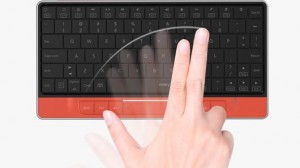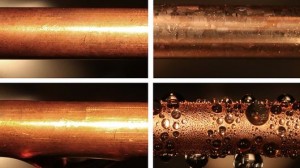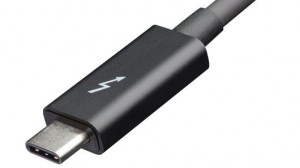Moky Bluetooth keyboard is also a trackpad
You can both type on Moky, and use it as a trackpad
We’ve seen a number of ideas for making Bluetooth portable keyboards that are compact yet still not frustratingly tiny – these have included devices that project virtual keys, devices that fold, and that can be rolled up. The Moky keyboard, however, takes a different approach. It saves space by allowing its keyboard area to double as a multi-touch trackpad.
According to the Seoul-based Moky company, the device uses “infrared laser sensors” to overlay an invisible trackpad on top of the keyboard. It lets users perform actions such as clicking/dragging, scrolling, swiping, pinching in and zooming out, simply by making the traditional finger movements directly above the keys.
While it isn’t clear exactly how the system works, the principle appears to be the same as that used by Continental’s “infrared curtain” technology for multi-touch displays in cars. In that case, a raised rectangular frame around the display has a series of LEDs along two adjacent sides, and a series of photodiodes along the other two. Each LED emits a beam of infrared light, which is picked up and converted into an electrical signal by the photodiode located in the corresponding spot on the opposite side of the frame.
When the user reaches through the grid of infrared light beams in a given location, their finger blocks some of the beams. Those beams’ photodiodes temporarily stop receiving light, and thus cease sending a signal. By analyzing the combination of affected photodiodes, the system can determine the location of the user’s finger relative to what’s being displayed on the screen, in real time.
Some of Moky’s other features include pantograph (i.e: individually spring-loaded) keys, an aluminum body, a folding cover that also serves as a smartphone/tablet stand, and a rechargeable battery that should be good for a claimed three months of use per charge (based on about four hours of use per day). The keyboard utilizes Bluetooth LE, and is compatible with iOS, Android and Windows devices.
Moky is currently the subject of an Indiegogo crowdfunding campaign, where a pledge of US$69 will currently get you one – when and if the keyboard reaches production. You can see it in use, in the pitch video below.
And although Moky may end up being the first true keyboard/trackpad hybrid to make it to market, this certainly isn’t the first time that the concept has been conceived of. Microsoft Research’s prototype Type-Hover-Swipe keyboard uses an array of infrared proximity sensors located between the keys to achieve the same ends, while Apple’s patent for the Fusion keyboard incorporates touch sensors in the surface of the keys.
Reference:http://www.gizmag.com/





